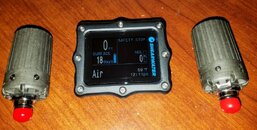Stuart, changing to a larger or smaller capacity tank size does not alter the volume SAC rate or RMV of a diver:
Seriously? Have you ever taken a Reading class? Is English your native language?
This is a thread about the Shearwater Perdix AI. The Perdix AI manual clearly defines SAC - which is the definition I am using in this thread, and I have posted SW's definition in this thread. It also happens to be the definition most people I know of use, too.
SAC is the rate of change of the tank pressure over time, normalized to 1 ATA. Let me try to put that in simple enough terms for you. SAC is the number of PSI that your tank drops in 1 minute, converted to what it would be if you were at the surface. If you're at 33' (which is 2ATA) and your tank drops 50 psi in 1 minute, then that's a SAC of 25 psi/min.
So, yes, as a matter of fact, SAC DOES change, for a given diver, if they change to a larger or smaller tank.
And where did I EVER say that a given diver's RMV changes based on tank size? I said that a SAC of 25 means a lower RMV if you're using an AL80 vs an HP120. I didn't say a given person's RMV was going to change if they get a bigger tank. I said IF their SAC is 25 with an AL80, then their RMV is lower than IF their SAC is 25 with an HP120.
And my original post that you have been jumping all over - but never quite hitting - was in response to another poster who said something about needing to enter tank sizes into the Perdix AI in order for it to tell you your SAC. I was explaining why you didn't need to do that and why you would need to, if you wanted the Perdix to tell you RMV.
That's as simple as I can make it for you. You don't seem to understand pretty simple high school level (or lower) English. And you think that using expensive electronics with batteries and O-rings on the battery covers is okay for the most critical dive data, but less expensive electronics (with a years long track record already, I might add) is not okay for less important data because it's not reliable enough. And the expensive electronics can be trusted to calculate your average depth, but not your ascent plan, and that doing it in your head is more reliable. Good luck with all that. Maybe you should take a basic Logic class, too. I won't be surprised to read that you seriously bend yourself someday operating like that.
Anyway, like I said, I've given it my best shot in explaining it to you. I can't do any better. So, I'm done responding to you.




